Strategic Analysis of Organisational Transformation at Walmart
VerifiedAdded on 2022/10/18
|20
|4471
|44
Report
AI Summary
This report provides a detailed analysis of organisational transformation, focusing on Walmart as a case study. It begins with an introduction to organisational transformation and development, emphasizing the need for strategic changes to achieve competitive advantage. The report explores various models, including Weisbord's Six Box Model, the Congruence Model of Nadler-Tushman, and the Galbraith Star Model, to diagnose organisational issues and develop effective strategies. Force field analysis is used to assess the forces driving and resisting change within Walmart. The study further examines intervention strategies, implementation, and the management of change processes. The report highlights the importance of effective communication, creating readiness for change, and managing resistance. The conclusion summarizes key findings and offers reflections on the challenges and opportunities of organisational transformation, with recommendations for sustainable growth and employee retention. The report also includes a review of Walmart’s mission, vision, objectives, and strategies, along with an overview of the issues faced by the company and the purpose and objectives of the study. Primary and secondary data sources are used to support the analysis, covering topics such as organizational culture and change.
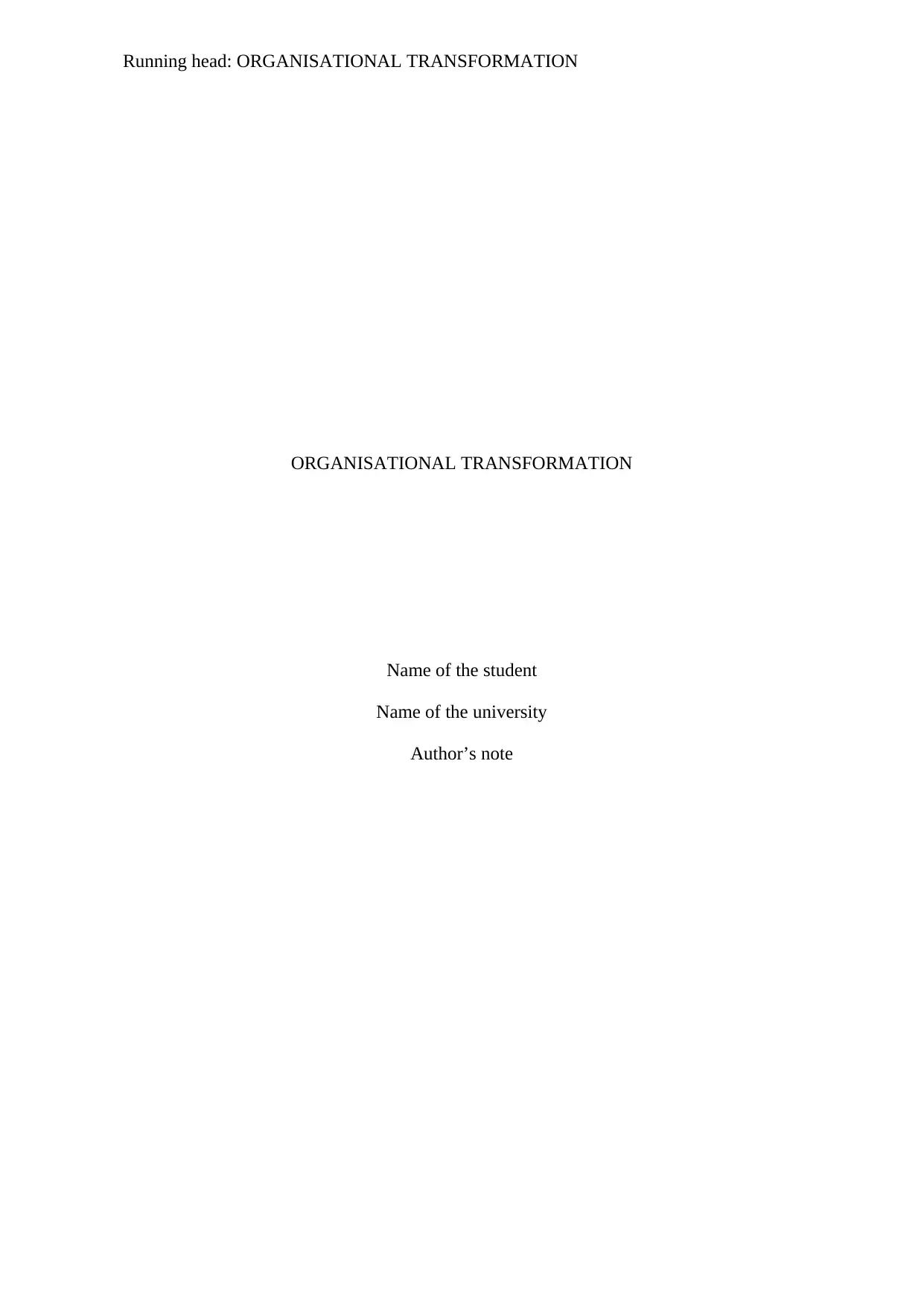
Running head: ORGANISATIONAL TRANSFORMATION
ORGANISATIONAL TRANSFORMATION
Name of the student
Name of the university
Author’s note
ORGANISATIONAL TRANSFORMATION
Name of the student
Name of the university
Author’s note
Paraphrase This Document
Need a fresh take? Get an instant paraphrase of this document with our AI Paraphraser
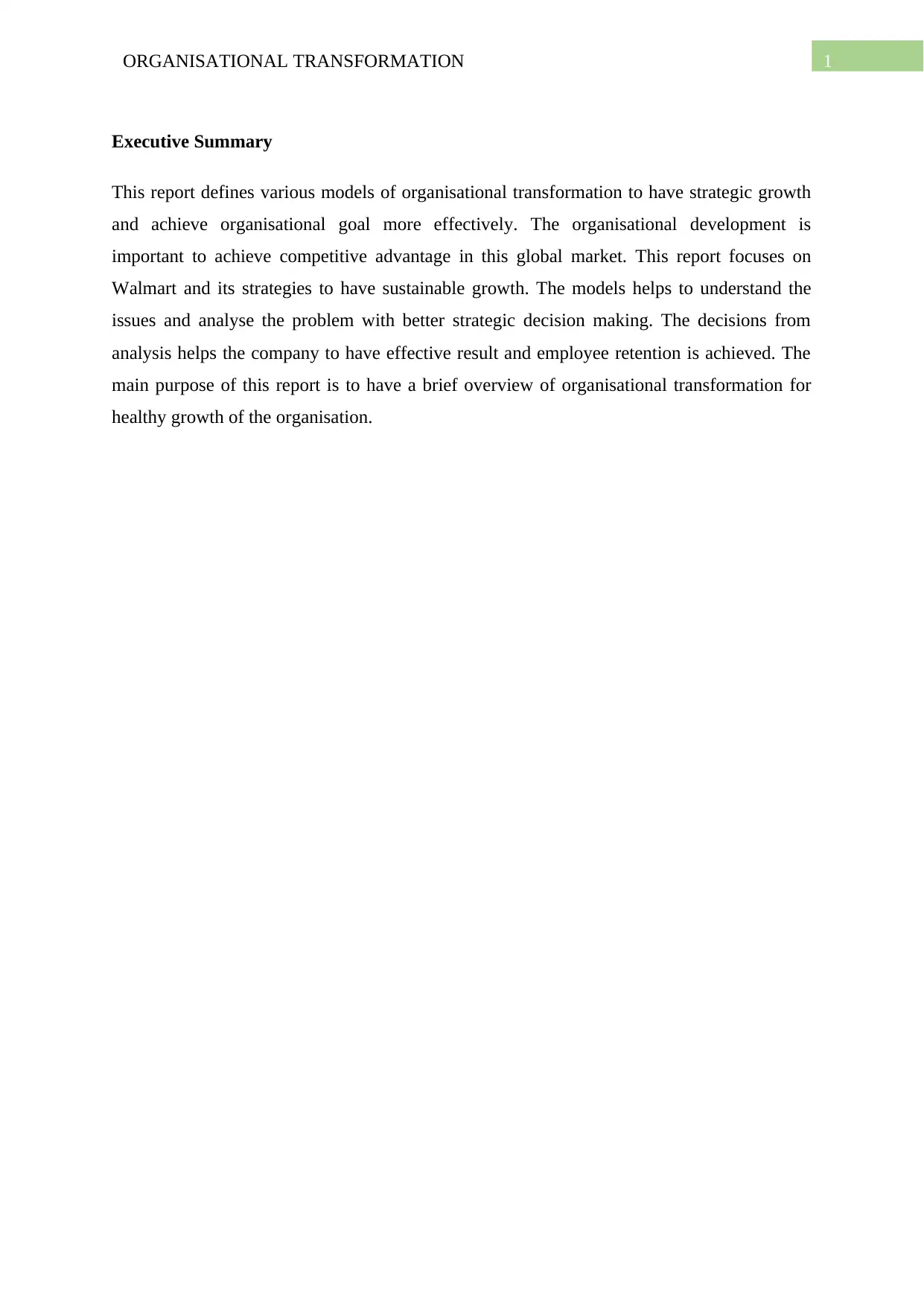
1ORGANISATIONAL TRANSFORMATION
Executive Summary
This report defines various models of organisational transformation to have strategic growth
and achieve organisational goal more effectively. The organisational development is
important to achieve competitive advantage in this global market. This report focuses on
Walmart and its strategies to have sustainable growth. The models helps to understand the
issues and analyse the problem with better strategic decision making. The decisions from
analysis helps the company to have effective result and employee retention is achieved. The
main purpose of this report is to have a brief overview of organisational transformation for
healthy growth of the organisation.
Executive Summary
This report defines various models of organisational transformation to have strategic growth
and achieve organisational goal more effectively. The organisational development is
important to achieve competitive advantage in this global market. This report focuses on
Walmart and its strategies to have sustainable growth. The models helps to understand the
issues and analyse the problem with better strategic decision making. The decisions from
analysis helps the company to have effective result and employee retention is achieved. The
main purpose of this report is to have a brief overview of organisational transformation for
healthy growth of the organisation.
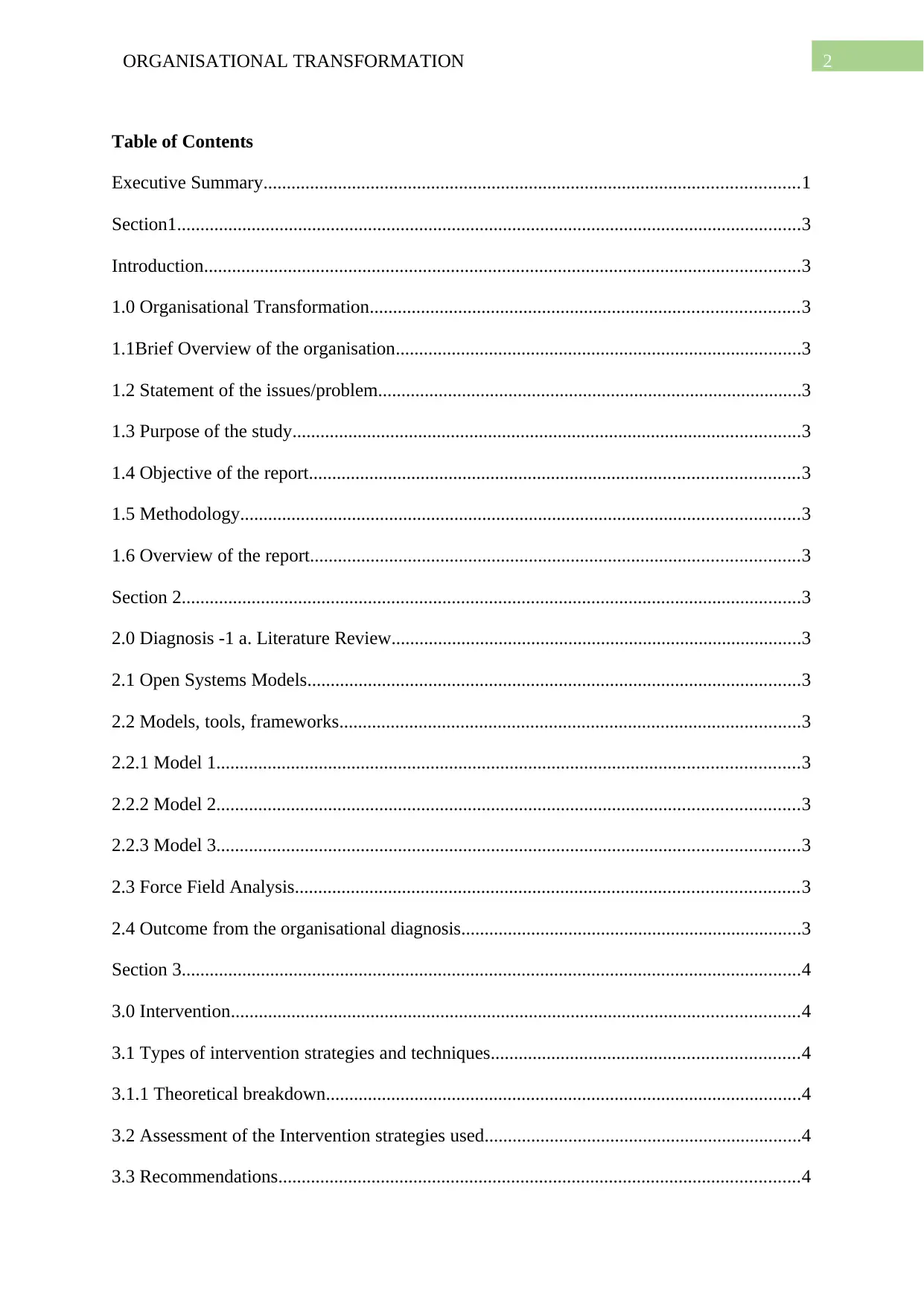
2ORGANISATIONAL TRANSFORMATION
Table of Contents
Executive Summary...................................................................................................................1
Section1......................................................................................................................................3
Introduction................................................................................................................................3
1.0 Organisational Transformation............................................................................................3
1.1Brief Overview of the organisation.......................................................................................3
1.2 Statement of the issues/problem...........................................................................................3
1.3 Purpose of the study.............................................................................................................3
1.4 Objective of the report.........................................................................................................3
1.5 Methodology........................................................................................................................3
1.6 Overview of the report.........................................................................................................3
Section 2.....................................................................................................................................3
2.0 Diagnosis -1 a. Literature Review........................................................................................3
2.1 Open Systems Models..........................................................................................................3
2.2 Models, tools, frameworks...................................................................................................3
2.2.1 Model 1.............................................................................................................................3
2.2.2 Model 2.............................................................................................................................3
2.2.3 Model 3.............................................................................................................................3
2.3 Force Field Analysis............................................................................................................3
2.4 Outcome from the organisational diagnosis.........................................................................3
Section 3.....................................................................................................................................4
3.0 Intervention..........................................................................................................................4
3.1 Types of intervention strategies and techniques..................................................................4
3.1.1 Theoretical breakdown......................................................................................................4
3.2 Assessment of the Intervention strategies used....................................................................4
3.3 Recommendations................................................................................................................4
Table of Contents
Executive Summary...................................................................................................................1
Section1......................................................................................................................................3
Introduction................................................................................................................................3
1.0 Organisational Transformation............................................................................................3
1.1Brief Overview of the organisation.......................................................................................3
1.2 Statement of the issues/problem...........................................................................................3
1.3 Purpose of the study.............................................................................................................3
1.4 Objective of the report.........................................................................................................3
1.5 Methodology........................................................................................................................3
1.6 Overview of the report.........................................................................................................3
Section 2.....................................................................................................................................3
2.0 Diagnosis -1 a. Literature Review........................................................................................3
2.1 Open Systems Models..........................................................................................................3
2.2 Models, tools, frameworks...................................................................................................3
2.2.1 Model 1.............................................................................................................................3
2.2.2 Model 2.............................................................................................................................3
2.2.3 Model 3.............................................................................................................................3
2.3 Force Field Analysis............................................................................................................3
2.4 Outcome from the organisational diagnosis.........................................................................3
Section 3.....................................................................................................................................4
3.0 Intervention..........................................................................................................................4
3.1 Types of intervention strategies and techniques..................................................................4
3.1.1 Theoretical breakdown......................................................................................................4
3.2 Assessment of the Intervention strategies used....................................................................4
3.3 Recommendations................................................................................................................4
⊘ This is a preview!⊘
Do you want full access?
Subscribe today to unlock all pages.

Trusted by 1+ million students worldwide
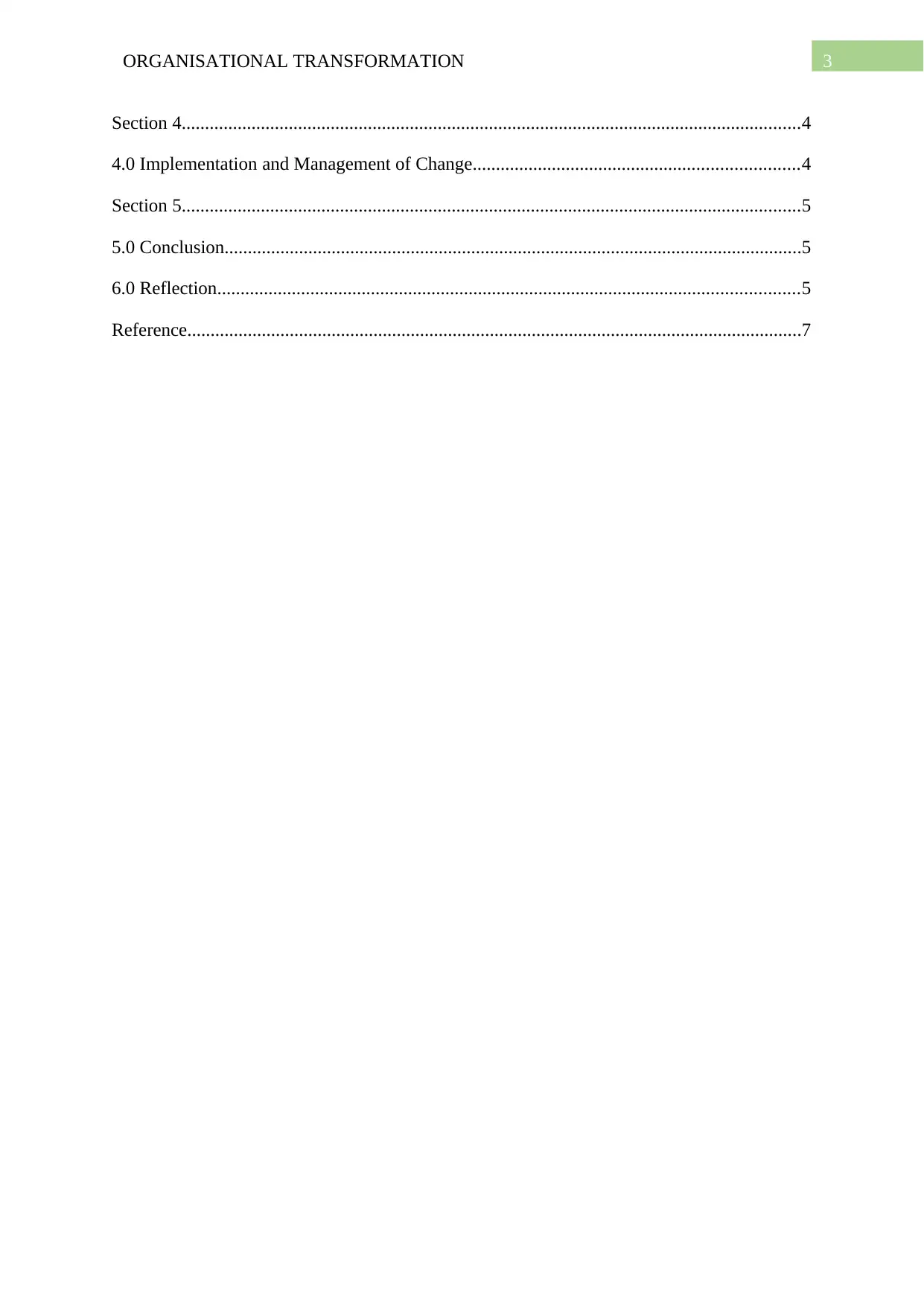
3ORGANISATIONAL TRANSFORMATION
Section 4.....................................................................................................................................4
4.0 Implementation and Management of Change......................................................................4
Section 5.....................................................................................................................................5
5.0 Conclusion............................................................................................................................5
6.0 Reflection.............................................................................................................................5
Reference....................................................................................................................................7
Section 4.....................................................................................................................................4
4.0 Implementation and Management of Change......................................................................4
Section 5.....................................................................................................................................5
5.0 Conclusion............................................................................................................................5
6.0 Reflection.............................................................................................................................5
Reference....................................................................................................................................7
Paraphrase This Document
Need a fresh take? Get an instant paraphrase of this document with our AI Paraphraser
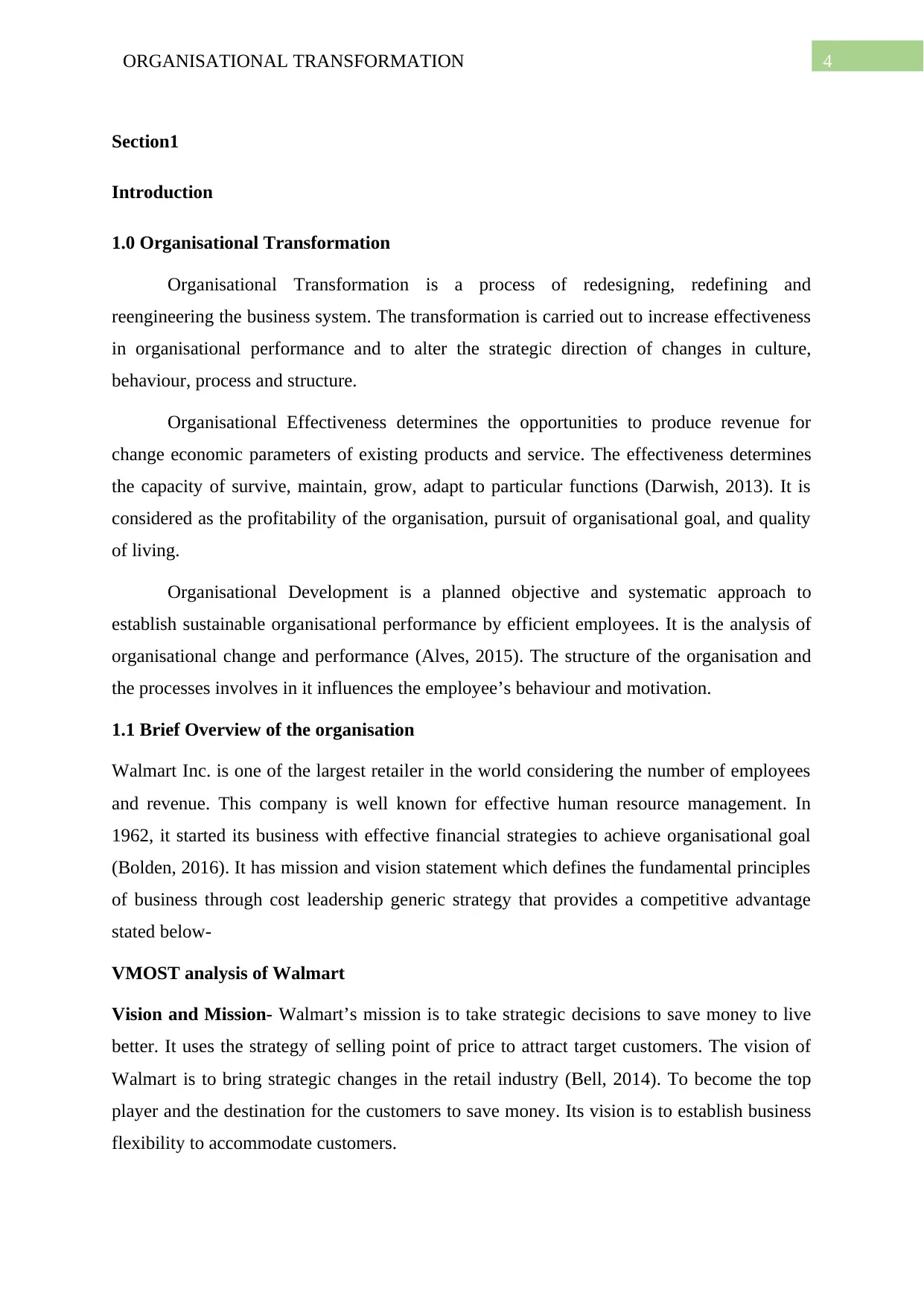
4ORGANISATIONAL TRANSFORMATION
Section1
Introduction
1.0 Organisational Transformation
Organisational Transformation is a process of redesigning, redefining and
reengineering the business system. The transformation is carried out to increase effectiveness
in organisational performance and to alter the strategic direction of changes in culture,
behaviour, process and structure.
Organisational Effectiveness determines the opportunities to produce revenue for
change economic parameters of existing products and service. The effectiveness determines
the capacity of survive, maintain, grow, adapt to particular functions (Darwish, 2013). It is
considered as the profitability of the organisation, pursuit of organisational goal, and quality
of living.
Organisational Development is a planned objective and systematic approach to
establish sustainable organisational performance by efficient employees. It is the analysis of
organisational change and performance (Alves, 2015). The structure of the organisation and
the processes involves in it influences the employee’s behaviour and motivation.
1.1 Brief Overview of the organisation
Walmart Inc. is one of the largest retailer in the world considering the number of employees
and revenue. This company is well known for effective human resource management. In
1962, it started its business with effective financial strategies to achieve organisational goal
(Bolden, 2016). It has mission and vision statement which defines the fundamental principles
of business through cost leadership generic strategy that provides a competitive advantage
stated below-
VMOST analysis of Walmart
Vision and Mission- Walmart’s mission is to take strategic decisions to save money to live
better. It uses the strategy of selling point of price to attract target customers. The vision of
Walmart is to bring strategic changes in the retail industry (Bell, 2014). To become the top
player and the destination for the customers to save money. Its vision is to establish business
flexibility to accommodate customers.
Section1
Introduction
1.0 Organisational Transformation
Organisational Transformation is a process of redesigning, redefining and
reengineering the business system. The transformation is carried out to increase effectiveness
in organisational performance and to alter the strategic direction of changes in culture,
behaviour, process and structure.
Organisational Effectiveness determines the opportunities to produce revenue for
change economic parameters of existing products and service. The effectiveness determines
the capacity of survive, maintain, grow, adapt to particular functions (Darwish, 2013). It is
considered as the profitability of the organisation, pursuit of organisational goal, and quality
of living.
Organisational Development is a planned objective and systematic approach to
establish sustainable organisational performance by efficient employees. It is the analysis of
organisational change and performance (Alves, 2015). The structure of the organisation and
the processes involves in it influences the employee’s behaviour and motivation.
1.1 Brief Overview of the organisation
Walmart Inc. is one of the largest retailer in the world considering the number of employees
and revenue. This company is well known for effective human resource management. In
1962, it started its business with effective financial strategies to achieve organisational goal
(Bolden, 2016). It has mission and vision statement which defines the fundamental principles
of business through cost leadership generic strategy that provides a competitive advantage
stated below-
VMOST analysis of Walmart
Vision and Mission- Walmart’s mission is to take strategic decisions to save money to live
better. It uses the strategy of selling point of price to attract target customers. The vision of
Walmart is to bring strategic changes in the retail industry (Bell, 2014). To become the top
player and the destination for the customers to save money. Its vision is to establish business
flexibility to accommodate customers.
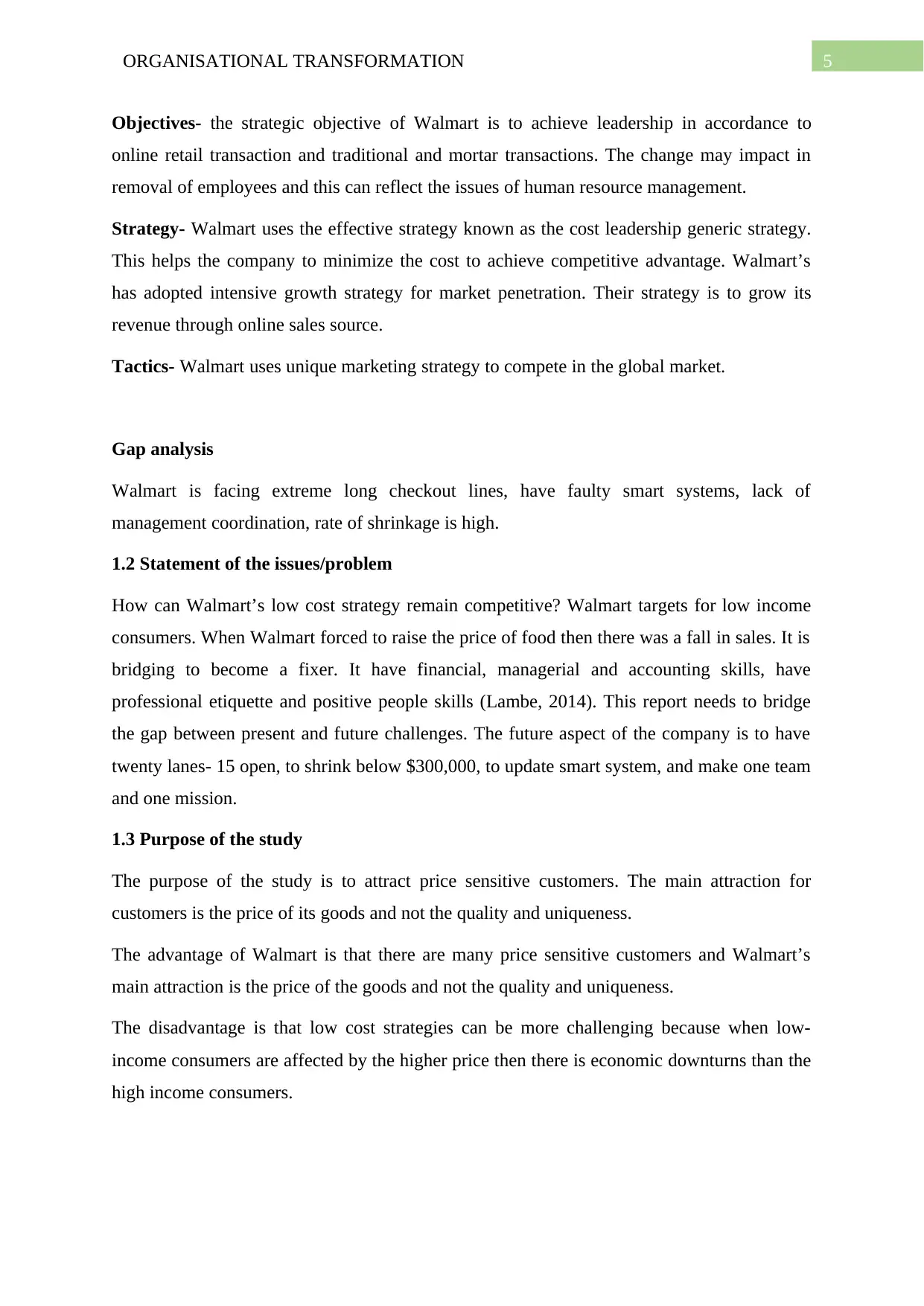
5ORGANISATIONAL TRANSFORMATION
Objectives- the strategic objective of Walmart is to achieve leadership in accordance to
online retail transaction and traditional and mortar transactions. The change may impact in
removal of employees and this can reflect the issues of human resource management.
Strategy- Walmart uses the effective strategy known as the cost leadership generic strategy.
This helps the company to minimize the cost to achieve competitive advantage. Walmart’s
has adopted intensive growth strategy for market penetration. Their strategy is to grow its
revenue through online sales source.
Tactics- Walmart uses unique marketing strategy to compete in the global market.
Gap analysis
Walmart is facing extreme long checkout lines, have faulty smart systems, lack of
management coordination, rate of shrinkage is high.
1.2 Statement of the issues/problem
How can Walmart’s low cost strategy remain competitive? Walmart targets for low income
consumers. When Walmart forced to raise the price of food then there was a fall in sales. It is
bridging to become a fixer. It have financial, managerial and accounting skills, have
professional etiquette and positive people skills (Lambe, 2014). This report needs to bridge
the gap between present and future challenges. The future aspect of the company is to have
twenty lanes- 15 open, to shrink below $300,000, to update smart system, and make one team
and one mission.
1.3 Purpose of the study
The purpose of the study is to attract price sensitive customers. The main attraction for
customers is the price of its goods and not the quality and uniqueness.
The advantage of Walmart is that there are many price sensitive customers and Walmart’s
main attraction is the price of the goods and not the quality and uniqueness.
The disadvantage is that low cost strategies can be more challenging because when low-
income consumers are affected by the higher price then there is economic downturns than the
high income consumers.
Objectives- the strategic objective of Walmart is to achieve leadership in accordance to
online retail transaction and traditional and mortar transactions. The change may impact in
removal of employees and this can reflect the issues of human resource management.
Strategy- Walmart uses the effective strategy known as the cost leadership generic strategy.
This helps the company to minimize the cost to achieve competitive advantage. Walmart’s
has adopted intensive growth strategy for market penetration. Their strategy is to grow its
revenue through online sales source.
Tactics- Walmart uses unique marketing strategy to compete in the global market.
Gap analysis
Walmart is facing extreme long checkout lines, have faulty smart systems, lack of
management coordination, rate of shrinkage is high.
1.2 Statement of the issues/problem
How can Walmart’s low cost strategy remain competitive? Walmart targets for low income
consumers. When Walmart forced to raise the price of food then there was a fall in sales. It is
bridging to become a fixer. It have financial, managerial and accounting skills, have
professional etiquette and positive people skills (Lambe, 2014). This report needs to bridge
the gap between present and future challenges. The future aspect of the company is to have
twenty lanes- 15 open, to shrink below $300,000, to update smart system, and make one team
and one mission.
1.3 Purpose of the study
The purpose of the study is to attract price sensitive customers. The main attraction for
customers is the price of its goods and not the quality and uniqueness.
The advantage of Walmart is that there are many price sensitive customers and Walmart’s
main attraction is the price of the goods and not the quality and uniqueness.
The disadvantage is that low cost strategies can be more challenging because when low-
income consumers are affected by the higher price then there is economic downturns than the
high income consumers.
⊘ This is a preview!⊘
Do you want full access?
Subscribe today to unlock all pages.

Trusted by 1+ million students worldwide
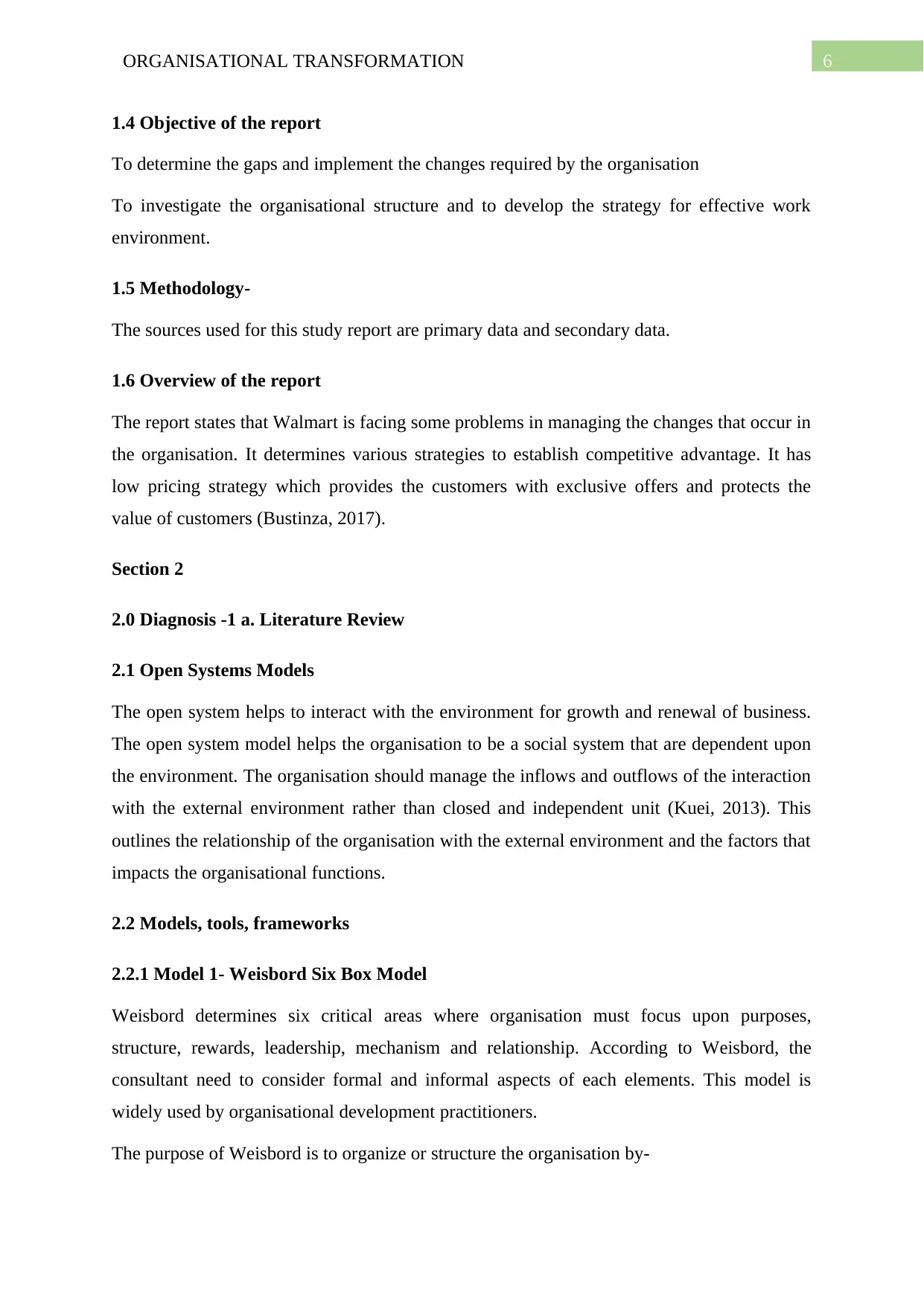
6ORGANISATIONAL TRANSFORMATION
1.4 Objective of the report
To determine the gaps and implement the changes required by the organisation
To investigate the organisational structure and to develop the strategy for effective work
environment.
1.5 Methodology-
The sources used for this study report are primary data and secondary data.
1.6 Overview of the report
The report states that Walmart is facing some problems in managing the changes that occur in
the organisation. It determines various strategies to establish competitive advantage. It has
low pricing strategy which provides the customers with exclusive offers and protects the
value of customers (Bustinza, 2017).
Section 2
2.0 Diagnosis -1 a. Literature Review
2.1 Open Systems Models
The open system helps to interact with the environment for growth and renewal of business.
The open system model helps the organisation to be a social system that are dependent upon
the environment. The organisation should manage the inflows and outflows of the interaction
with the external environment rather than closed and independent unit (Kuei, 2013). This
outlines the relationship of the organisation with the external environment and the factors that
impacts the organisational functions.
2.2 Models, tools, frameworks
2.2.1 Model 1- Weisbord Six Box Model
Weisbord determines six critical areas where organisation must focus upon purposes,
structure, rewards, leadership, mechanism and relationship. According to Weisbord, the
consultant need to consider formal and informal aspects of each elements. This model is
widely used by organisational development practitioners.
The purpose of Weisbord is to organize or structure the organisation by-
1.4 Objective of the report
To determine the gaps and implement the changes required by the organisation
To investigate the organisational structure and to develop the strategy for effective work
environment.
1.5 Methodology-
The sources used for this study report are primary data and secondary data.
1.6 Overview of the report
The report states that Walmart is facing some problems in managing the changes that occur in
the organisation. It determines various strategies to establish competitive advantage. It has
low pricing strategy which provides the customers with exclusive offers and protects the
value of customers (Bustinza, 2017).
Section 2
2.0 Diagnosis -1 a. Literature Review
2.1 Open Systems Models
The open system helps to interact with the environment for growth and renewal of business.
The open system model helps the organisation to be a social system that are dependent upon
the environment. The organisation should manage the inflows and outflows of the interaction
with the external environment rather than closed and independent unit (Kuei, 2013). This
outlines the relationship of the organisation with the external environment and the factors that
impacts the organisational functions.
2.2 Models, tools, frameworks
2.2.1 Model 1- Weisbord Six Box Model
Weisbord determines six critical areas where organisation must focus upon purposes,
structure, rewards, leadership, mechanism and relationship. According to Weisbord, the
consultant need to consider formal and informal aspects of each elements. This model is
widely used by organisational development practitioners.
The purpose of Weisbord is to organize or structure the organisation by-
Paraphrase This Document
Need a fresh take? Get an instant paraphrase of this document with our AI Paraphraser
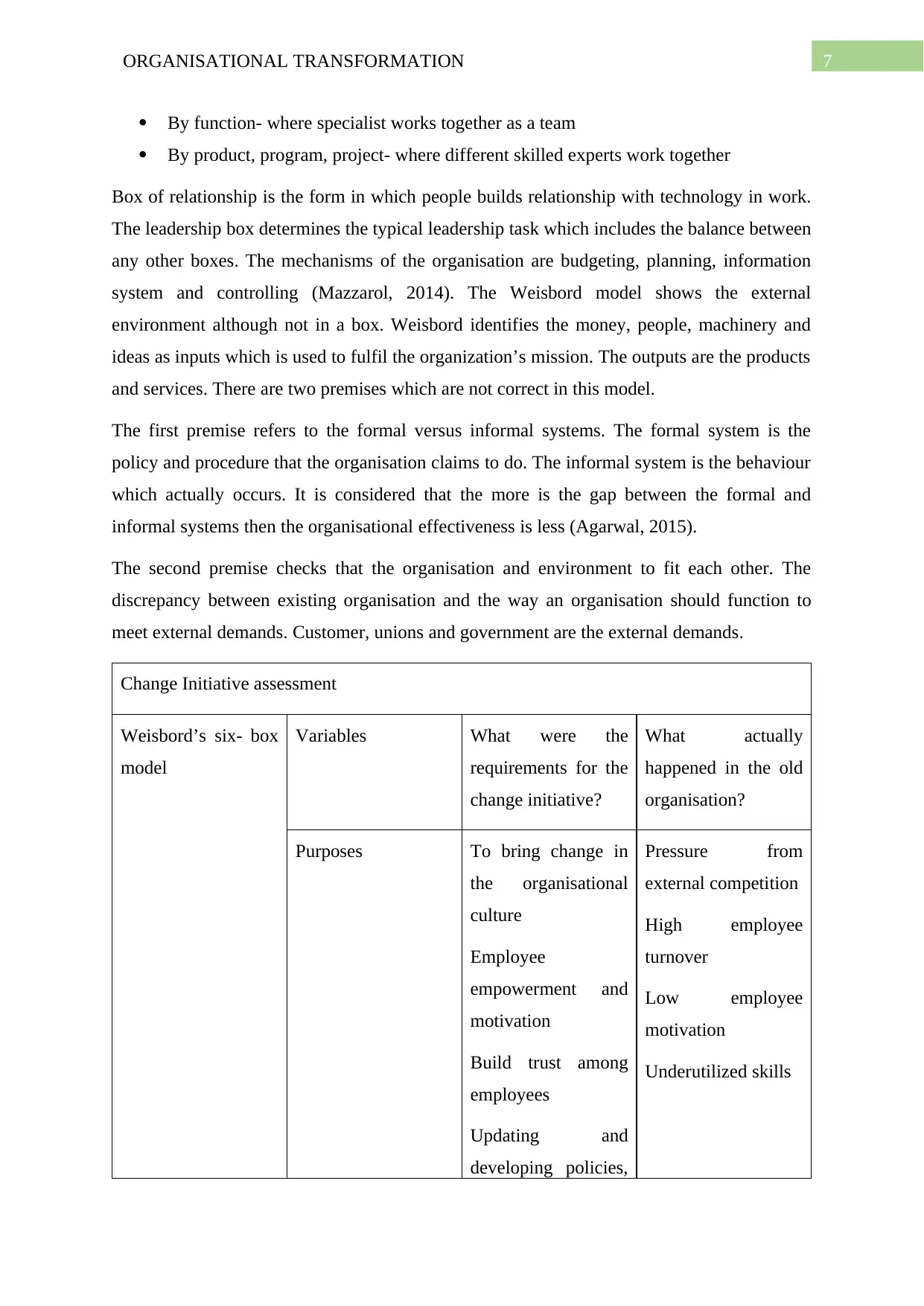
7ORGANISATIONAL TRANSFORMATION
By function- where specialist works together as a team
By product, program, project- where different skilled experts work together
Box of relationship is the form in which people builds relationship with technology in work.
The leadership box determines the typical leadership task which includes the balance between
any other boxes. The mechanisms of the organisation are budgeting, planning, information
system and controlling (Mazzarol, 2014). The Weisbord model shows the external
environment although not in a box. Weisbord identifies the money, people, machinery and
ideas as inputs which is used to fulfil the organization’s mission. The outputs are the products
and services. There are two premises which are not correct in this model.
The first premise refers to the formal versus informal systems. The formal system is the
policy and procedure that the organisation claims to do. The informal system is the behaviour
which actually occurs. It is considered that the more is the gap between the formal and
informal systems then the organisational effectiveness is less (Agarwal, 2015).
The second premise checks that the organisation and environment to fit each other. The
discrepancy between existing organisation and the way an organisation should function to
meet external demands. Customer, unions and government are the external demands.
Change Initiative assessment
Weisbord’s six- box
model
Variables What were the
requirements for the
change initiative?
What actually
happened in the old
organisation?
Purposes To bring change in
the organisational
culture
Employee
empowerment and
motivation
Build trust among
employees
Updating and
developing policies,
Pressure from
external competition
High employee
turnover
Low employee
motivation
Underutilized skills
By function- where specialist works together as a team
By product, program, project- where different skilled experts work together
Box of relationship is the form in which people builds relationship with technology in work.
The leadership box determines the typical leadership task which includes the balance between
any other boxes. The mechanisms of the organisation are budgeting, planning, information
system and controlling (Mazzarol, 2014). The Weisbord model shows the external
environment although not in a box. Weisbord identifies the money, people, machinery and
ideas as inputs which is used to fulfil the organization’s mission. The outputs are the products
and services. There are two premises which are not correct in this model.
The first premise refers to the formal versus informal systems. The formal system is the
policy and procedure that the organisation claims to do. The informal system is the behaviour
which actually occurs. It is considered that the more is the gap between the formal and
informal systems then the organisational effectiveness is less (Agarwal, 2015).
The second premise checks that the organisation and environment to fit each other. The
discrepancy between existing organisation and the way an organisation should function to
meet external demands. Customer, unions and government are the external demands.
Change Initiative assessment
Weisbord’s six- box
model
Variables What were the
requirements for the
change initiative?
What actually
happened in the old
organisation?
Purposes To bring change in
the organisational
culture
Employee
empowerment and
motivation
Build trust among
employees
Updating and
developing policies,
Pressure from
external competition
High employee
turnover
Low employee
motivation
Underutilized skills
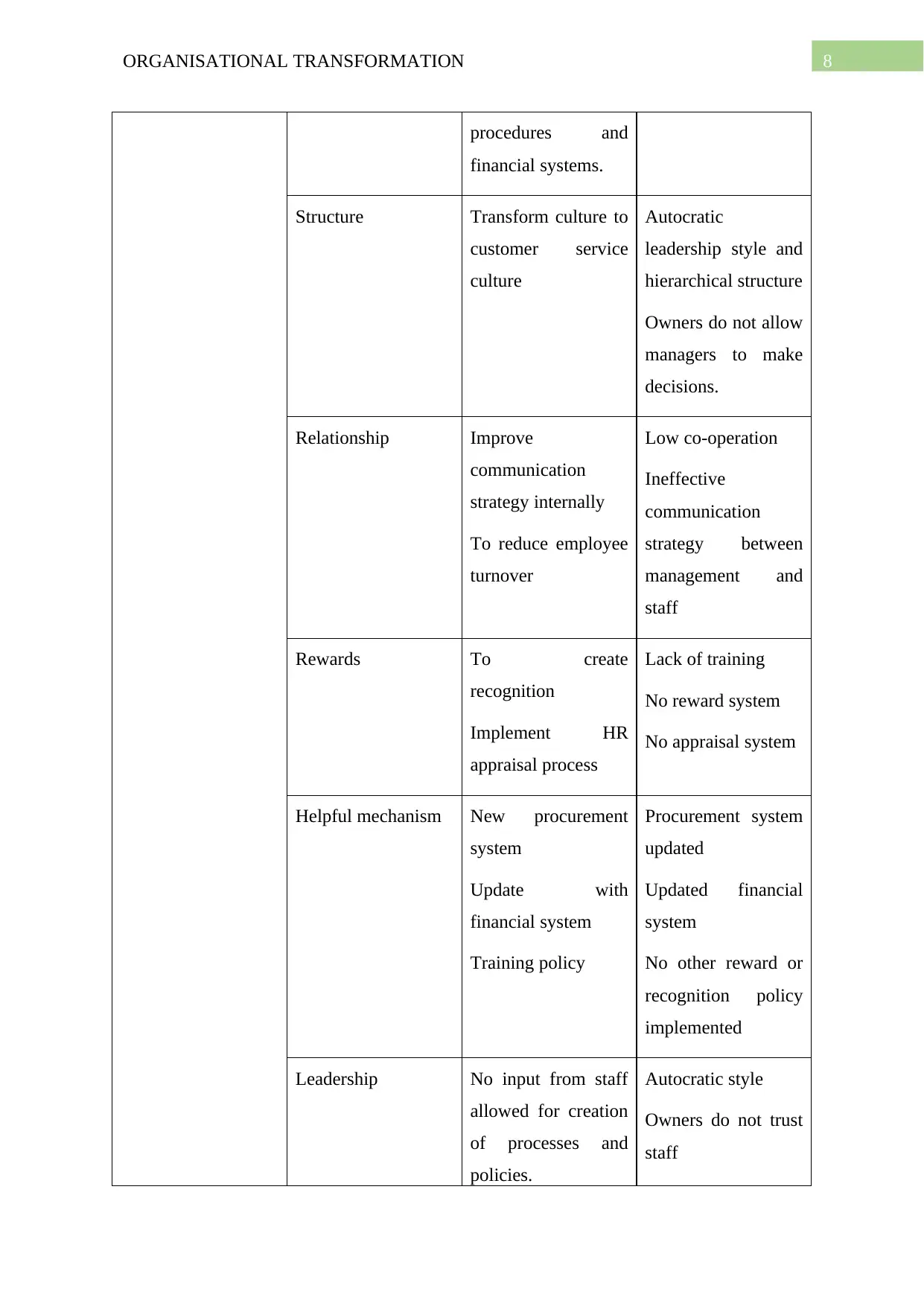
8ORGANISATIONAL TRANSFORMATION
procedures and
financial systems.
Structure Transform culture to
customer service
culture
Autocratic
leadership style and
hierarchical structure
Owners do not allow
managers to make
decisions.
Relationship Improve
communication
strategy internally
To reduce employee
turnover
Low co-operation
Ineffective
communication
strategy between
management and
staff
Rewards To create
recognition
Implement HR
appraisal process
Lack of training
No reward system
No appraisal system
Helpful mechanism New procurement
system
Update with
financial system
Training policy
Procurement system
updated
Updated financial
system
No other reward or
recognition policy
implemented
Leadership No input from staff
allowed for creation
of processes and
policies.
Autocratic style
Owners do not trust
staff
procedures and
financial systems.
Structure Transform culture to
customer service
culture
Autocratic
leadership style and
hierarchical structure
Owners do not allow
managers to make
decisions.
Relationship Improve
communication
strategy internally
To reduce employee
turnover
Low co-operation
Ineffective
communication
strategy between
management and
staff
Rewards To create
recognition
Implement HR
appraisal process
Lack of training
No reward system
No appraisal system
Helpful mechanism New procurement
system
Update with
financial system
Training policy
Procurement system
updated
Updated financial
system
No other reward or
recognition policy
implemented
Leadership No input from staff
allowed for creation
of processes and
policies.
Autocratic style
Owners do not trust
staff
⊘ This is a preview!⊘
Do you want full access?
Subscribe today to unlock all pages.

Trusted by 1+ million students worldwide
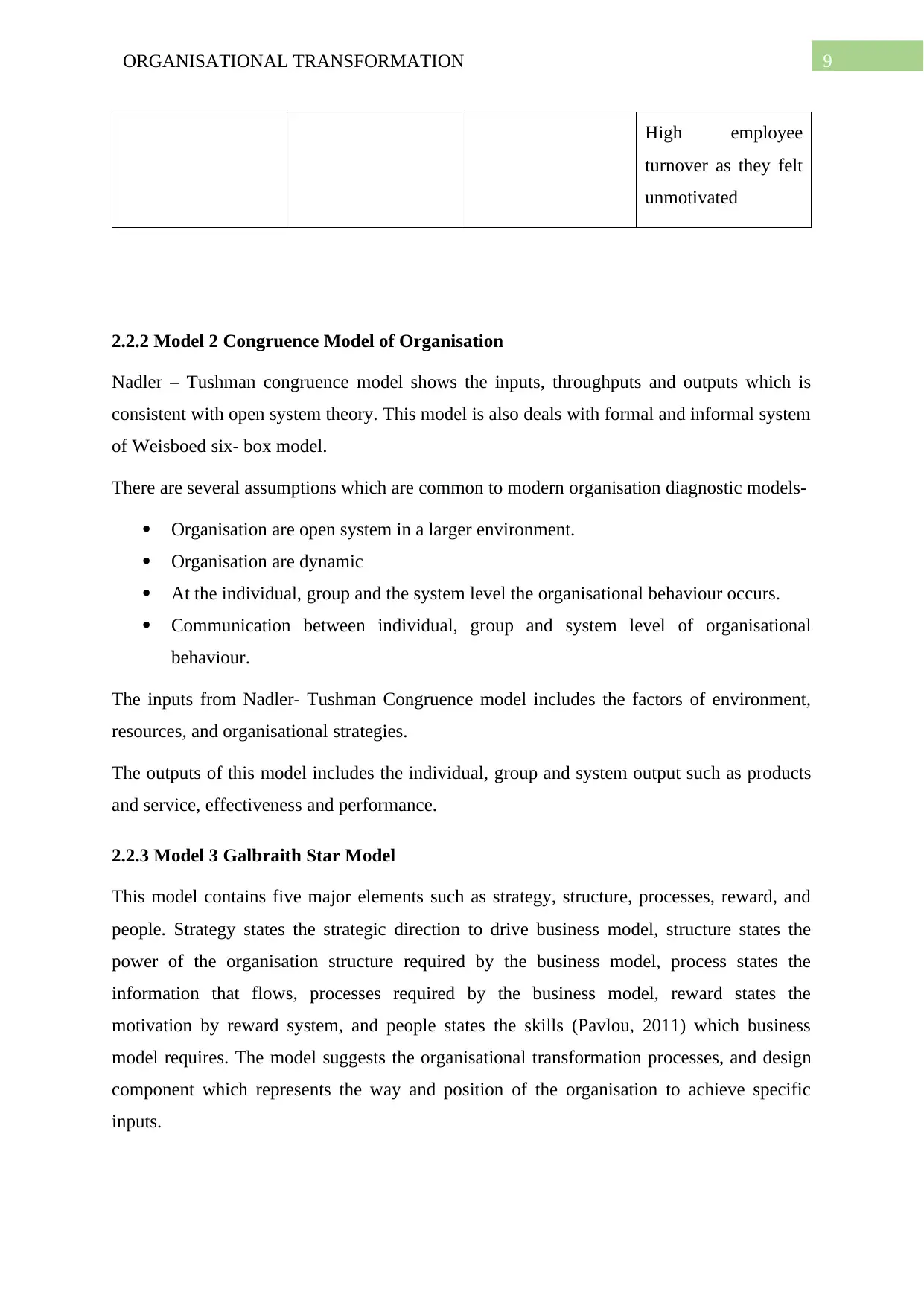
9ORGANISATIONAL TRANSFORMATION
High employee
turnover as they felt
unmotivated
2.2.2 Model 2 Congruence Model of Organisation
Nadler – Tushman congruence model shows the inputs, throughputs and outputs which is
consistent with open system theory. This model is also deals with formal and informal system
of Weisboed six- box model.
There are several assumptions which are common to modern organisation diagnostic models-
Organisation are open system in a larger environment.
Organisation are dynamic
At the individual, group and the system level the organisational behaviour occurs.
Communication between individual, group and system level of organisational
behaviour.
The inputs from Nadler- Tushman Congruence model includes the factors of environment,
resources, and organisational strategies.
The outputs of this model includes the individual, group and system output such as products
and service, effectiveness and performance.
2.2.3 Model 3 Galbraith Star Model
This model contains five major elements such as strategy, structure, processes, reward, and
people. Strategy states the strategic direction to drive business model, structure states the
power of the organisation structure required by the business model, process states the
information that flows, processes required by the business model, reward states the
motivation by reward system, and people states the skills (Pavlou, 2011) which business
model requires. The model suggests the organisational transformation processes, and design
component which represents the way and position of the organisation to achieve specific
inputs.
High employee
turnover as they felt
unmotivated
2.2.2 Model 2 Congruence Model of Organisation
Nadler – Tushman congruence model shows the inputs, throughputs and outputs which is
consistent with open system theory. This model is also deals with formal and informal system
of Weisboed six- box model.
There are several assumptions which are common to modern organisation diagnostic models-
Organisation are open system in a larger environment.
Organisation are dynamic
At the individual, group and the system level the organisational behaviour occurs.
Communication between individual, group and system level of organisational
behaviour.
The inputs from Nadler- Tushman Congruence model includes the factors of environment,
resources, and organisational strategies.
The outputs of this model includes the individual, group and system output such as products
and service, effectiveness and performance.
2.2.3 Model 3 Galbraith Star Model
This model contains five major elements such as strategy, structure, processes, reward, and
people. Strategy states the strategic direction to drive business model, structure states the
power of the organisation structure required by the business model, process states the
information that flows, processes required by the business model, reward states the
motivation by reward system, and people states the skills (Pavlou, 2011) which business
model requires. The model suggests the organisational transformation processes, and design
component which represents the way and position of the organisation to achieve specific
inputs.
Paraphrase This Document
Need a fresh take? Get an instant paraphrase of this document with our AI Paraphraser
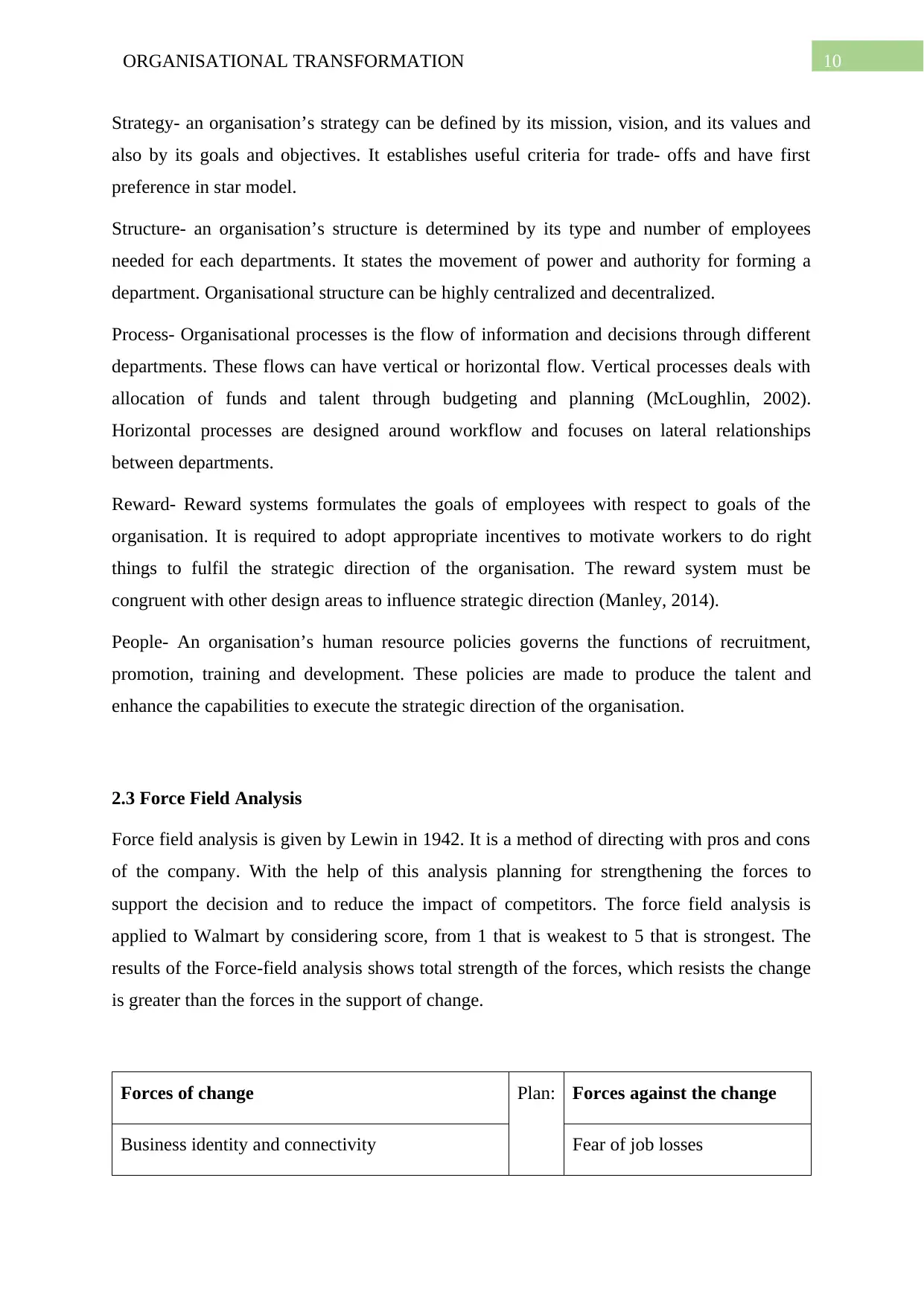
10ORGANISATIONAL TRANSFORMATION
Strategy- an organisation’s strategy can be defined by its mission, vision, and its values and
also by its goals and objectives. It establishes useful criteria for trade- offs and have first
preference in star model.
Structure- an organisation’s structure is determined by its type and number of employees
needed for each departments. It states the movement of power and authority for forming a
department. Organisational structure can be highly centralized and decentralized.
Process- Organisational processes is the flow of information and decisions through different
departments. These flows can have vertical or horizontal flow. Vertical processes deals with
allocation of funds and talent through budgeting and planning (McLoughlin, 2002).
Horizontal processes are designed around workflow and focuses on lateral relationships
between departments.
Reward- Reward systems formulates the goals of employees with respect to goals of the
organisation. It is required to adopt appropriate incentives to motivate workers to do right
things to fulfil the strategic direction of the organisation. The reward system must be
congruent with other design areas to influence strategic direction (Manley, 2014).
People- An organisation’s human resource policies governs the functions of recruitment,
promotion, training and development. These policies are made to produce the talent and
enhance the capabilities to execute the strategic direction of the organisation.
2.3 Force Field Analysis
Force field analysis is given by Lewin in 1942. It is a method of directing with pros and cons
of the company. With the help of this analysis planning for strengthening the forces to
support the decision and to reduce the impact of competitors. The force field analysis is
applied to Walmart by considering score, from 1 that is weakest to 5 that is strongest. The
results of the Force-field analysis shows total strength of the forces, which resists the change
is greater than the forces in the support of change.
Forces of change Plan: Forces against the change
Business identity and connectivity Fear of job losses
Strategy- an organisation’s strategy can be defined by its mission, vision, and its values and
also by its goals and objectives. It establishes useful criteria for trade- offs and have first
preference in star model.
Structure- an organisation’s structure is determined by its type and number of employees
needed for each departments. It states the movement of power and authority for forming a
department. Organisational structure can be highly centralized and decentralized.
Process- Organisational processes is the flow of information and decisions through different
departments. These flows can have vertical or horizontal flow. Vertical processes deals with
allocation of funds and talent through budgeting and planning (McLoughlin, 2002).
Horizontal processes are designed around workflow and focuses on lateral relationships
between departments.
Reward- Reward systems formulates the goals of employees with respect to goals of the
organisation. It is required to adopt appropriate incentives to motivate workers to do right
things to fulfil the strategic direction of the organisation. The reward system must be
congruent with other design areas to influence strategic direction (Manley, 2014).
People- An organisation’s human resource policies governs the functions of recruitment,
promotion, training and development. These policies are made to produce the talent and
enhance the capabilities to execute the strategic direction of the organisation.
2.3 Force Field Analysis
Force field analysis is given by Lewin in 1942. It is a method of directing with pros and cons
of the company. With the help of this analysis planning for strengthening the forces to
support the decision and to reduce the impact of competitors. The force field analysis is
applied to Walmart by considering score, from 1 that is weakest to 5 that is strongest. The
results of the Force-field analysis shows total strength of the forces, which resists the change
is greater than the forces in the support of change.
Forces of change Plan: Forces against the change
Business identity and connectivity Fear of job losses
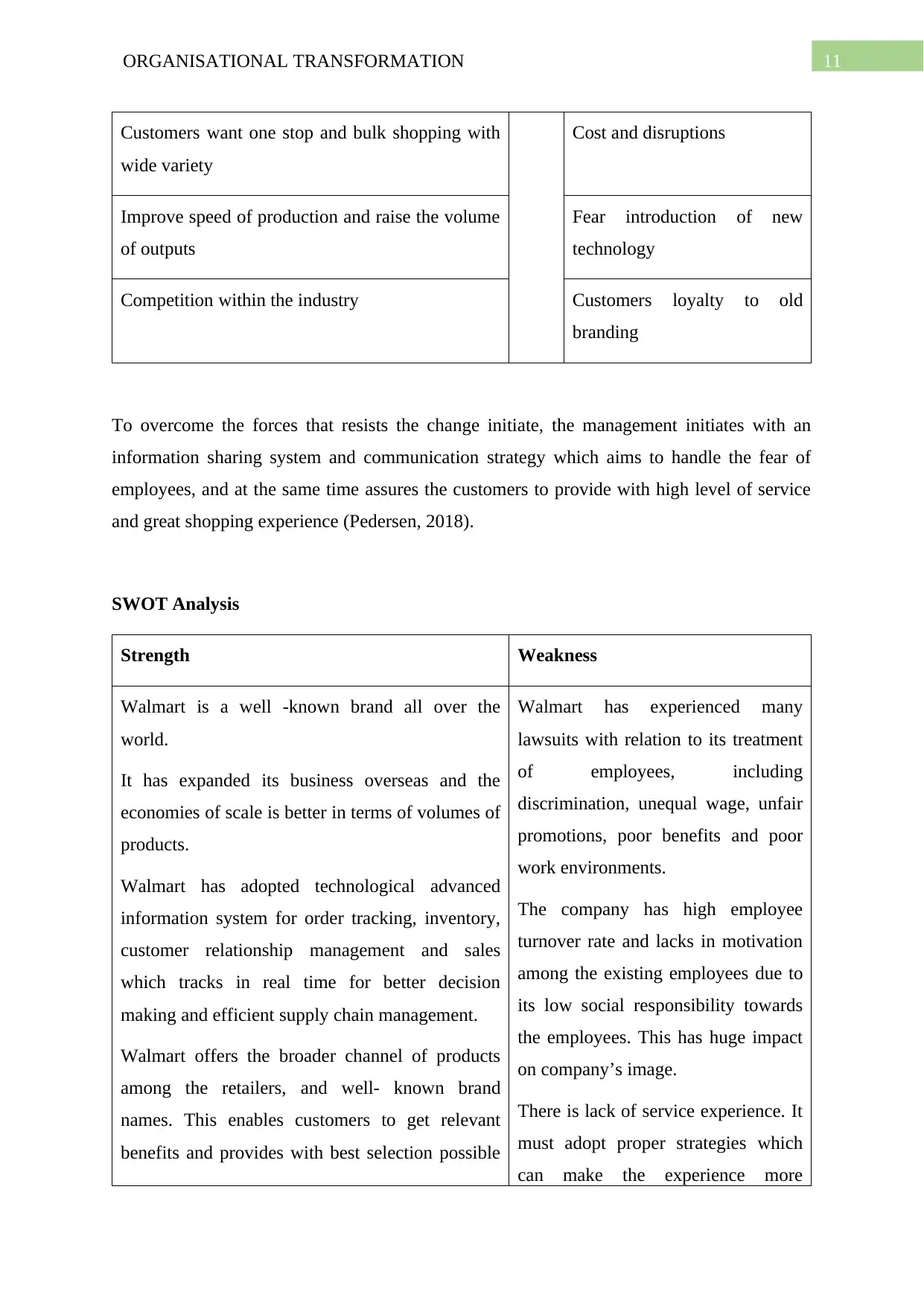
11ORGANISATIONAL TRANSFORMATION
Customers want one stop and bulk shopping with
wide variety
Cost and disruptions
Improve speed of production and raise the volume
of outputs
Fear introduction of new
technology
Competition within the industry Customers loyalty to old
branding
To overcome the forces that resists the change initiate, the management initiates with an
information sharing system and communication strategy which aims to handle the fear of
employees, and at the same time assures the customers to provide with high level of service
and great shopping experience (Pedersen, 2018).
SWOT Analysis
Strength Weakness
Walmart is a well -known brand all over the
world.
It has expanded its business overseas and the
economies of scale is better in terms of volumes of
products.
Walmart has adopted technological advanced
information system for order tracking, inventory,
customer relationship management and sales
which tracks in real time for better decision
making and efficient supply chain management.
Walmart offers the broader channel of products
among the retailers, and well- known brand
names. This enables customers to get relevant
benefits and provides with best selection possible
Walmart has experienced many
lawsuits with relation to its treatment
of employees, including
discrimination, unequal wage, unfair
promotions, poor benefits and poor
work environments.
The company has high employee
turnover rate and lacks in motivation
among the existing employees due to
its low social responsibility towards
the employees. This has huge impact
on company’s image.
There is lack of service experience. It
must adopt proper strategies which
can make the experience more
Customers want one stop and bulk shopping with
wide variety
Cost and disruptions
Improve speed of production and raise the volume
of outputs
Fear introduction of new
technology
Competition within the industry Customers loyalty to old
branding
To overcome the forces that resists the change initiate, the management initiates with an
information sharing system and communication strategy which aims to handle the fear of
employees, and at the same time assures the customers to provide with high level of service
and great shopping experience (Pedersen, 2018).
SWOT Analysis
Strength Weakness
Walmart is a well -known brand all over the
world.
It has expanded its business overseas and the
economies of scale is better in terms of volumes of
products.
Walmart has adopted technological advanced
information system for order tracking, inventory,
customer relationship management and sales
which tracks in real time for better decision
making and efficient supply chain management.
Walmart offers the broader channel of products
among the retailers, and well- known brand
names. This enables customers to get relevant
benefits and provides with best selection possible
Walmart has experienced many
lawsuits with relation to its treatment
of employees, including
discrimination, unequal wage, unfair
promotions, poor benefits and poor
work environments.
The company has high employee
turnover rate and lacks in motivation
among the existing employees due to
its low social responsibility towards
the employees. This has huge impact
on company’s image.
There is lack of service experience. It
must adopt proper strategies which
can make the experience more
⊘ This is a preview!⊘
Do you want full access?
Subscribe today to unlock all pages.

Trusted by 1+ million students worldwide
1 out of 20
Related Documents
Your All-in-One AI-Powered Toolkit for Academic Success.
+13062052269
info@desklib.com
Available 24*7 on WhatsApp / Email
![[object Object]](/_next/static/media/star-bottom.7253800d.svg)
Unlock your academic potential
Copyright © 2020–2025 A2Z Services. All Rights Reserved. Developed and managed by ZUCOL.



